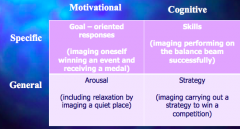![]()
![]()
![]()
Use LEFT and RIGHT arrow keys to navigate between flashcards;
Use UP and DOWN arrow keys to flip the card;
H to show hint;
A reads text to speech;
21 Cards in this Set
- Front
- Back
|
name the "senses" associated with imagery
|
○kinesthetic sense
○visual sense ○auditory sense ○tactile sense ○olfactory sense |
|
|
define internal imagery
|
you imagine the execution of a skill from your own vantage point
|
|
|
define external imagery
|
you view yourself from the perspective of an outside observer
|
|
|
factors that affect the effectiveness of imagery
|
○nature of the task
○skill level of the performer ○imaging ability ○using imagery along with physical practice ○personality |
|
|
describe psychoneuromuscular theory
|
imagery facilitates the learning of motor skills because of the nature of the neuromuscular activity patterns activated during imagery
|
|
|
describe symbolic learning theory
|
suggests imagery may function as coding system to help people understand and acquire movement patterns.
movement patterns symbolically coded in CNS= blueprint. |
|
|
describe bioinformational theory
|
a description of an image consists of: response proposition (producing physiological activity: feel) and stimulus propositions (describing features of scenario:sights, sounds, smells).
perhaps the best developed explanation |
|
|
describe the triple code model
|
3 effects (ISM): (I) Itself, (S) Somatic response, and (M) the Meaning of the image
-primary importance is physiological of imagery and understanding imagery parts. |
|
|
uses of imagery:
|
○improve concentration
○enhance motivation ○build confidence ○control emotional responses ○acquire, practice, and correct sport skills ○acquire and practice strategy ○prepare for competition ○cope with pain and injury ○solve problems |
|
|
2 keys to effective imagery
|
○vividness
○controllability |
|
|
is internal or external imagery most affective?
|
internal, because those are things you can control
|
|
|
describe polysensory experiences
|
should involve all of the senses:
-visual -auditory -olfactory (smell) -tactile (touch) -kinesthetic (feel) |
|
|
functions of imagery
|

|
|
|
how can imagery have reverse affects on emotions?
|
-with negative or irrelevant thoughts
-cause too much anxiety -imaging failures -becoming overconfident |
|
|
factors affecting effectiveness
|
-type of task
-skill level -imaging ability -practice schedule (75:25 split) |
|
|
what is the 75:25 split?
|
75% physical workout + 25% mental workout, or imagery = optimal condition
|
|
|
what is the point of 75:25 split?
|
allows for physical rest and recovery.
opportunity for active problem solving in a risk-free environment |
|
|
what does the SIQ do?
|
Sports Imaging Questionnaire, determines how strong imaging skills are and which senses most in touch with.
|
|
|
why is mental practice effective?
|
1. psychonueromuscular explanation
2. symbolic explanation 3. bioinformational explanation 4. triple code explanation |
|
|
when do we use imagery?
|
-pre and post practice (10 min max)
-pre and post competition (individualized) -natural breaks in competition -personal time/recovery |
|
|
PETTLEP
|
Physical nature of the movement
Environment (the specifics) Task (type) Timing (of the movement) Learning (content of the movement) Emotion (personal meaning of the movement) Perspective (internal or external) |

